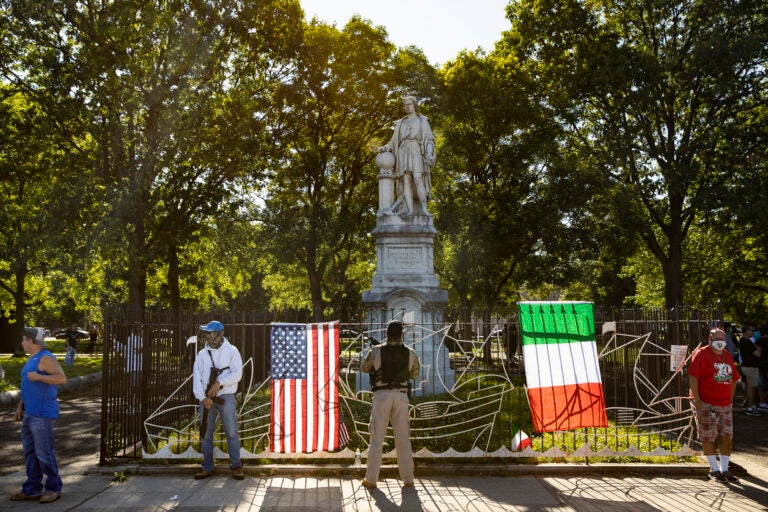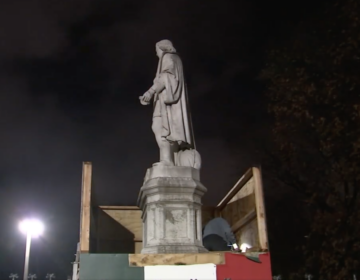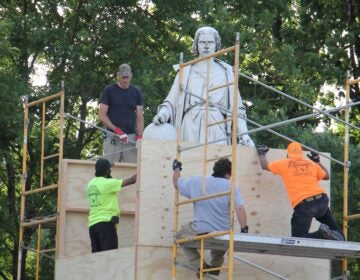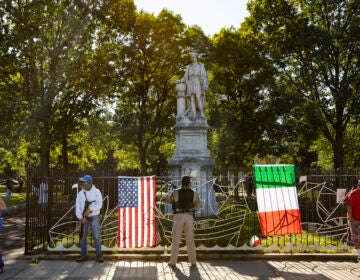Philadelphia Historical Commission votes to remove Marconi Plaza Christopher Columbus statue
The vote marks the second-to-last procedural hurdle for Mayor Jim Kenney’s proposal to remove the Marconi Plaza icon.

A group of armed people guard a statue of Christopher Columbus located in Marconi Park on South Broad St. These men said they believed that Black Lives Matter/ANTIFA protestors were on their way to destroy the statue. (Courtesy of Ryan Collerd)
The Philadelphia Historical Commission voted to approve a Kenney administration proposal to remove a Christopher Columbus statue that was the site of a violent confrontation last month and to place it in storage. The vote marks the second-to-last procedural hurdle for Mayor Jim Kenney’s proposal to remove the Marconi Plaza icon.
Nationwide protests over systemic racism and injustice have led to the toppling and removal of contentious statues and monuments across the country. Concerned that the South Philadelphia Columbus statue might be next, armed defenders congregated around the monument, physically and verbally assaulting protesters, prompting Kenney to put forth a proposal to remove the figure from the park in the interest of public safety. The Historical Commission meeting, the second in a series of special public meetings, came two days after a hearing held by the Philadelphia Art Commission and hours of public testimony.
Opinions represented on Wednesday were varied. Local residents, members of the Italian American community, and Indigenous people called in to advocate for the statue’s removal, noting that Columbus has come to sybolize white supremacy, colonialism, and genocide and that there are better figures or stories that exemplify Italian American culture to celebrate. Many also spoke in favor of keeping the statue, several of whom overlapped with a list of speakers prepared for Friday’s Historical Commission Meeting by George Bochetto, an attorney who represents various interest groups close to the issue.
The Art Commission held off voting on the matter, due to a court order, until August 12. The Art Commission will “digest” public input and will take the Historical Commission’s decision into consideration.
The statue was sculpted for and installed at the Centennial Exhibition in 1876 in West Fairmount Park. It was relocated to Marconi Plaza in 1976 and was listed on the historic register in 2017, after being nominated by Celeste Morello. The designation placed the statue under partial jurisdiction of the PHC.
Because the statue has already been listed on the Philadelphia Register, the PHC’s purview on this matter is unrelated to questions of the statue’s historical merit, the history and legacy of Christopher Columbus himself, or of what the statue has come to represent, a point that was repeatedly stressed by the Commissioners throughout the public testimony.
Despite repeated claims made by Bochetto that the PHC had a “duty” and “legal obligation” to consider the statue within its current environment, the criteria that the statue is listed under do not require such consideration.
At the time of designation, the PHC found that the statue satisfied criterion A and B because it represents the adoption of Columbus as “a symbol for the emerging nation by George Washington and others during the Revolutionary Era,” and for its association with the Centennial, thus placing it under the PHC’s partial jurisdiction.
Morello specified that she did not note the statue’s current location as relevant to its significance when she nominated it. In a letter submitted to Historical Commission Executive Director Jonathan Farnham, Morello stated that, due to a lack of historical record identifying a strong relationship to the site’s new location — and, she noted, absent any support or testimony by the various friends’ groups who are now concerned by the statue’s removal — “I did not include any relationship to the statue with that site.”
Bochetto and other supporters’ made repeated accusations that the city is skirting the legal process, but the two bodies who have authority over this decision — the Art Commission and the Historical Commission — have held public meetings, providing opportunities for robust public input and comment. Both commissions are advised by attorneys who work with the Law Department.
In response to false claims made during testimony, Danielle Walsh, an attorney with the Law Department, clarified that there was never an emergency order, or any plan of the Administration to make one, to remove the statue.
Many municipal offices have made the call to remove Columbus statues with far less input, most recently the city of Chicago, which removed its Columbus statue overnight as ordered by Mayor Lori Lightfoot.
As noted in the PHC staff overview, the City’s preservation ordinance prohibits “demolition” of a designated building, structure, site or object. “Demolition” as defined by the ordinance includes the removal of an object or building from its site, therefore requiring the Commission to weigh in on the statue’s potential removal.
Farnham emphasized that the issue before the PHC was “narrow” and was simply to determine if the removal of the statue would harm the historical value of the statue or have an otherwise adverse effect. Counterintuitively, based on the language in the ordinance, removing the statue from its original site constitutes “demolition,” which in this context legal counsel clarified, simply includes placing the statue in a safe storage facility with proper care and conservation and does not include any physical destruction of the statue.
Removal, or “demolition,” would require justification on the basis that maintaining the statue in place poses a threat to public safety, a case that the City laid out, citing recent incidents of violence beginning on June 13, when a group of people, some armed with rifles, baseball bats and other weapons gathered to “defend” the statue, resulting in sometimes violent clashes between the defenders and protesters.
Despite repeated pleas by Commissioners that commenters refrain from debating the history and legacy of Christopher Columbus, or even the historical merit of the statue, and to keep discussion to the issues within the Commission’s purview, the early lineup of speakers — nearly identical to Wednesday’s meeting — continued to attempt to make the case for Columbus as a laudable figure.
The remaining testimony was impassioned and included many of the same voices as the previous meeting.
Penny Balkin Bach, Executive Director of the Association for Public Art and Chair of the City’s Public Art Advisory Committee, spoke on behalf of the other committee members in praise of the City for boxing the statue in the interest of the artwork’s and public’s safety.
“As a lighting rod for dissent, its safety simply can’t be guaranteed,” Bach stated. “If the statue were to remain in place, we anticipate that it would become a symbol and a site for ongoing clashes between opposing groups and ideologies and that this would endanger the public, but particularly put this object at risk.”
Patrick Grossi, Director of Advocacy for the Preservation Alliance for Greater Philadelphia, said that the organization has no objection to the removal of the statue. “The Preservation Alliance realizes that cultural priorities and perceptions shift over time … for many this statue has come to symbolize some of the worst aspects of the history of Western civilization, namely slavery, colonialism, and the subjugation and dehumanizaiton of Indigenous peoples,” Grossi stated. “Simply put: these are not values or histories to be uncritically commemorated in a public park.”
Testimony continued into the afternoon, much of it from local residents and advocates regarding the statue’s symbolic weight, many repeating from Wednesday’s meeting, though there were some new voices who offered opinions geared more towards matters under the PHC’s consideration.
Mary Foster, a local educator who identified herself as coming from both Italian American and Native American descent, testified that she had witnessed some of the protests while walking nearby and the amount of “anger, rage, abuse” coming from the statue’s defenders was “horrific.” Foster continued, “The statue is a symbol of violence. I’ve always had an issue with that statue, I didn’t know who to voice my concern to, I didn’t know if I would be the only one.”
Caitlin Borrelli, who also introduced herself as an Italian American living Philadelphia stated that she believes the statue should be replaced under the guidance of local Indigenous groups. Many others spoke in solidarity with and support for Indigenous communities and voices calling for the statue’s removal.
Oscar Beisert of the Keeping Society, spoke to the city’s history of moving public art. Beisert felt that the Mayor should look to other examples nationwide for recontextualization and interpretation. Noting the “passion” of the local Italian American community for their heritage, Beisert concluded “it would be amazing to see that passion directed towards the designation and protection of places like the Italian Market and other Italian landmarks that are not listed on the Philadelphia Register of Historic Places.”
Following the public testimony, Mr. Bochetto was given the opportunity to respond, who again falsely claimed that the location of the statue was “integrally intertwined” with the decision to designate the statue.
Margot Berg, who delivered the initial presentation representing the City, reiterated that the Historical Commission would retain its jurisdiction over the future of the statue, if it is determined that it may be moved to storage, and will weigh in on any future proposals for relocation.
After much discussion, Commissioner Betty Turner reiterated that the Commission needed to focus on responding to the two questions being presented today: 1) whether or not to remove the statue for its own protection and 2) whether or not to remove it for public safety and welfare.
Commissioner Kim Washington urged the other members to reach a decision, “I think in order to both protect the statue and to protect public safety, the statue needs to be in a place where it won’t incite riots,” Washington said.
“If any public art comes to the point where you have citizens who are coming with guns, with baseball bats, with hammers … remove the public art,” Washington continued. “And I hate to say that. As a member of the Commission, of course we respect history and public art, but above all I respect life, human life … what happens to it in the future, if it comes back, that’s a very different conversation.”
The commissioners deliberated for nearly an hour, raising questions about where the statue might go, how it might be interpreted, and various stipulations that might be attached to its removal, the requirement to replace it with an interpretive plaque, for example.
With guidance from Leonard Reuter, legal counsel to PHC, the staff developed a series of stipulations for the statue’s removal. Commissioner Turner put forth a motion that the PHC approve the application for the statue’s removal in the interest of public safety with four stipulations: 1) that the statue be stored in an undisclosed, secure location in Philadelphia 2) that a conservator and firm involved in moving important works of art handle its removal 3) that the City will report to the PHC annually on the condition of the statue and 4) that the sculpture will be recorded and documented via digital scan.
The vote passed 10 to 2.

Get daily updates from WHYY News!
WHYY is your source for fact-based, in-depth journalism and information. As a nonprofit organization, we rely on financial support from readers like you. Please give today.







